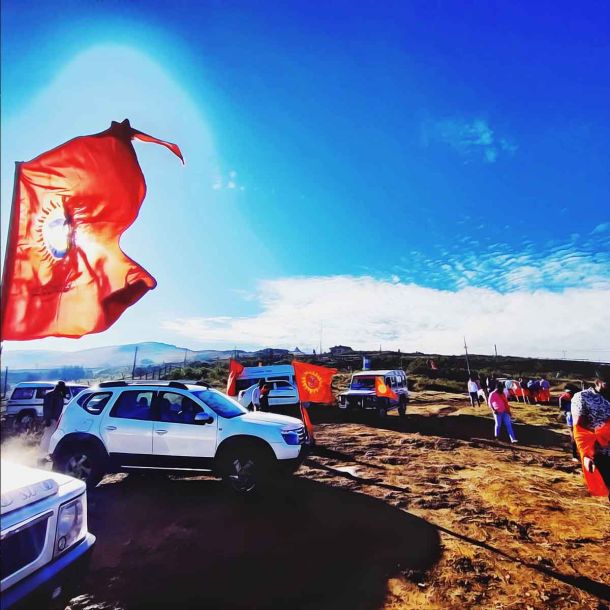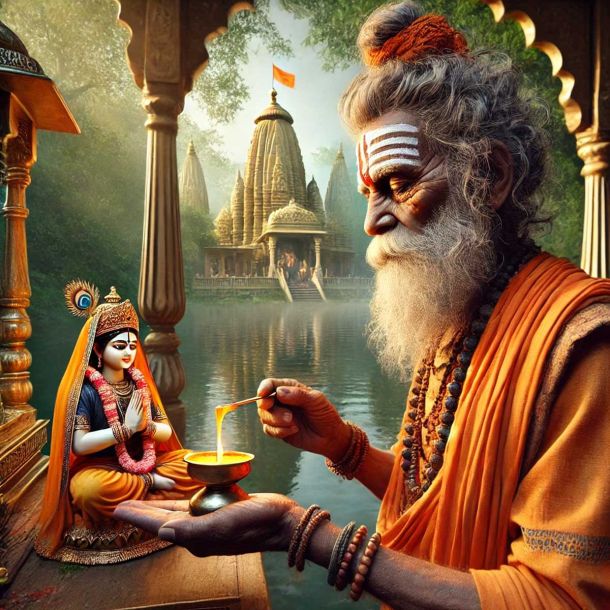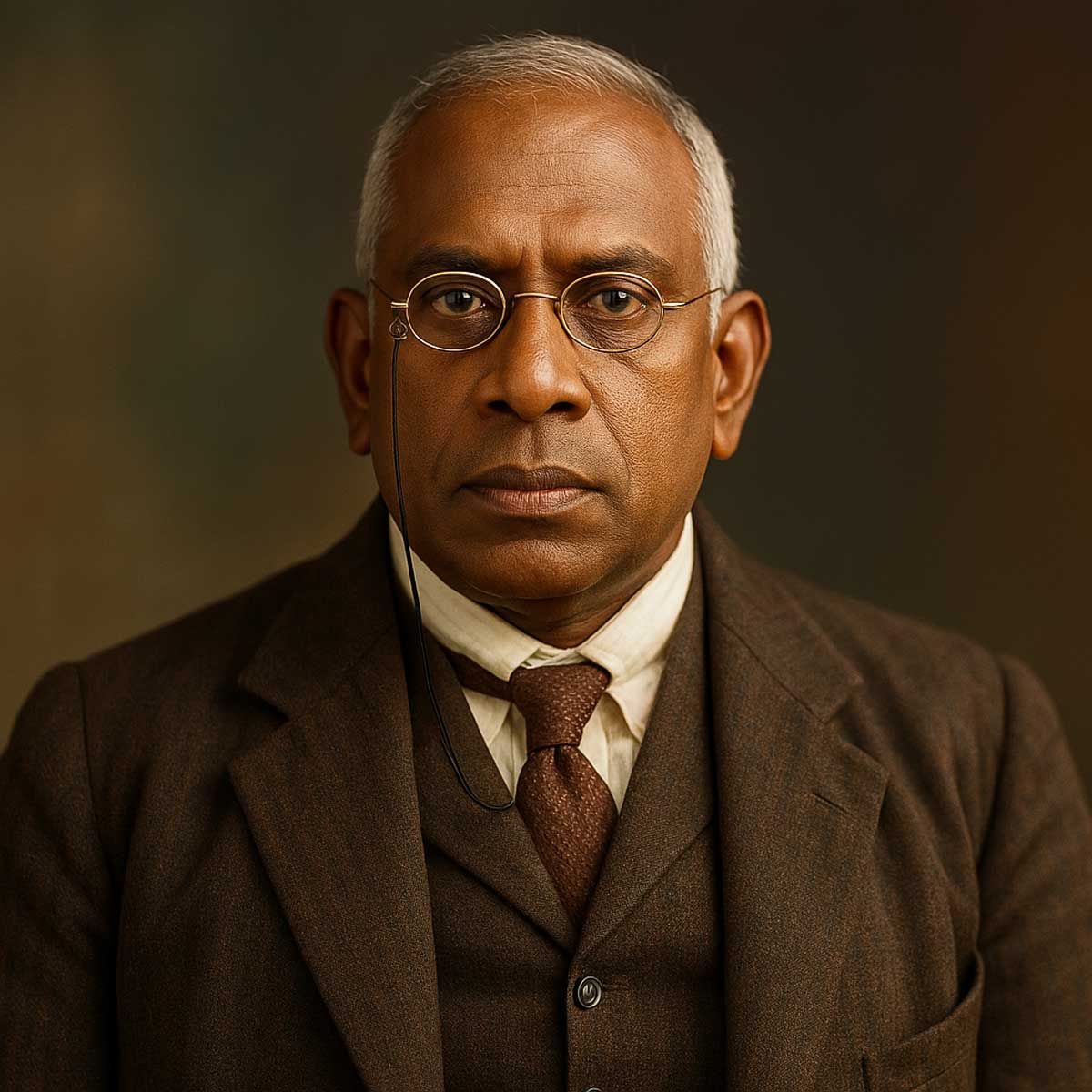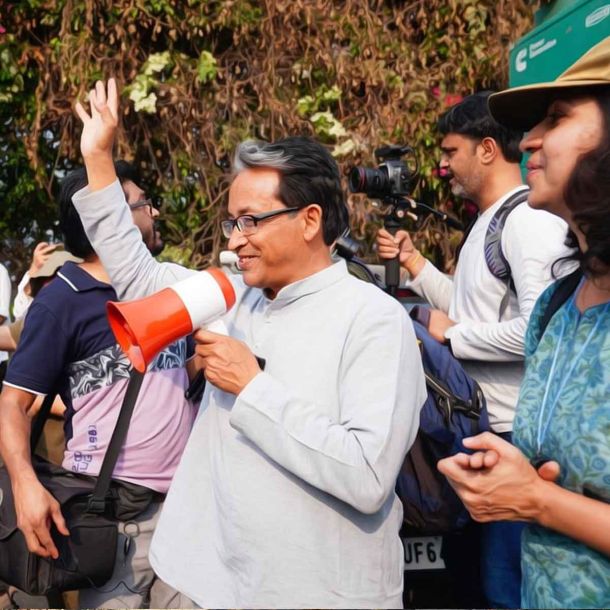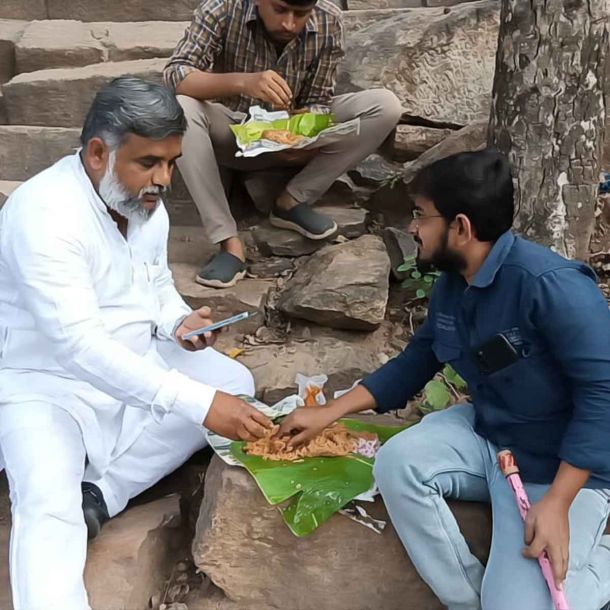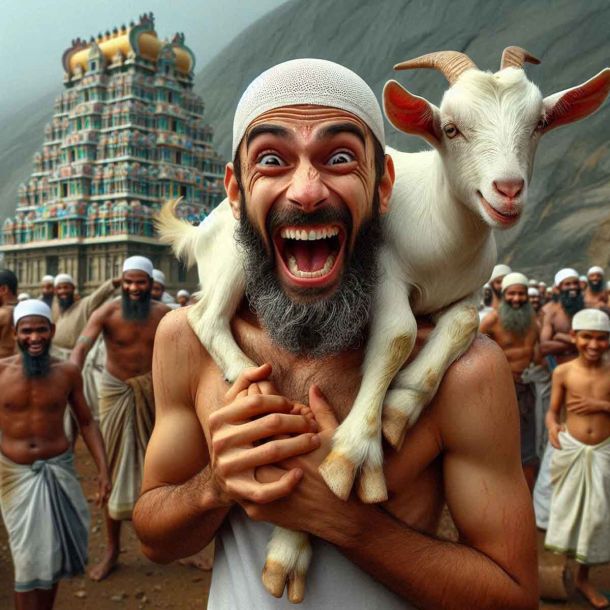More Coverage
Twitter Coverage
Satyaagrah
Written on
Satyaagrah
Written on
Satyaagrah
Written on
Satyaagrah
Written on
Satyaagrah
Written on
Join Satyaagrah Social Media
“When I make your peace, You Shall See My real color, My Viswaroopam, Prabhu Murugan”: This colossal gold painted statue of Sri Murugan, made from reinforced concrete and standing 140 feet tall isn’t in India, it’s in fact in Batu Caves in Malaysia
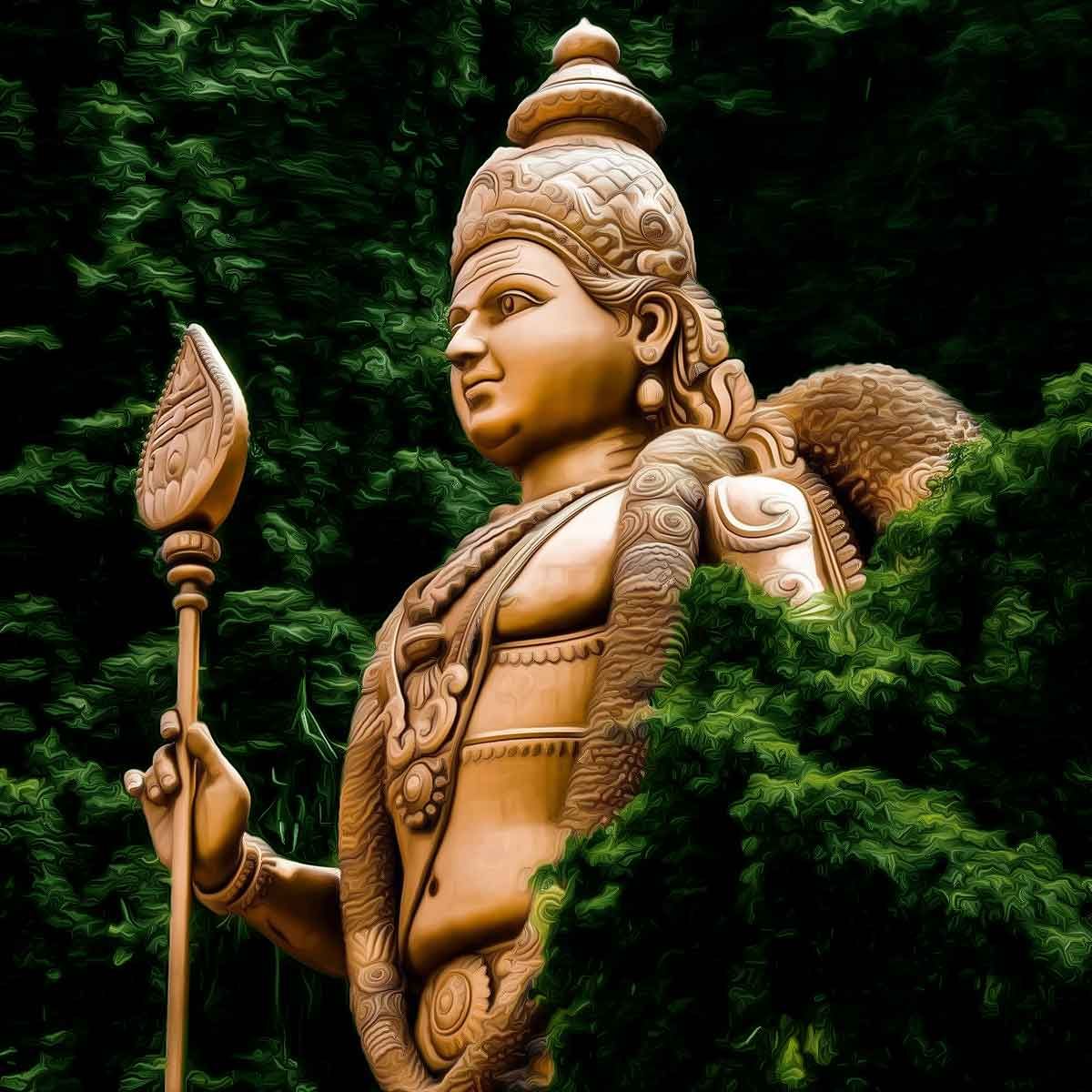
Batu Caves (Tamil: பத்து மலை : Pathumalai) is a mogote (a type of karst landform) that has a series of caves and cave temples in Gombak, Selangor, Malaysia. It takes its name from the Malay word batu, meaning 'rock'. The hill was originally known as Kapal Tanggang from the legend of Si Tanggang. The town nearby is named after the Batu Caves limestone formation.
|
The cave is one of the most popular Hindu shrines outside India and is dedicated to Lord Murugan. It is the focal point of the Tamil festival of Thaipusam in Malaysia.
Batu Caves in short also referred to as the 10th Caves or Hill for Lord Murugan as there are six important holy shrines in India and four more in Malaysia. The three others in Malaysia are Kallumalai Temple in Ipoh, Tanneermalai Temple in Penang, and Sannasimalai Temple in Malacca.
The limestone forming Batu Caves is said to be around 400 million years old. Some of the cave entrances were used as shelters by the indigenous Temuan / Besisi people (a tribe of Orang Asli). As early as 1860, Chinese settlers began excavating guano for fertilizing their vegetable patches. However, they became famous only after the limestone hills were recorded by colonial authorities including Daly and Syers as well as American Naturalist, William Hornaday in 1878.
Batu Caves was promoted as a place of worship by K. Thamboosamy Pillai, an Indian trader. He was inspired by the ‘vel’-shaped entrance of the main cave and was inspired to dedicate a temple to Lord Muruga within the caves.
The history of Batu Caves started in 1891 when Mr. K. Thamboosamy Pillai, who also founded the Sri Maha Mariamman Temple Dhevasthanam, Kuala Lumpur, send his very close associates, Sri Thiruvengadam Pillai and Sri Kanthapa Thevar to survey for an ideal ad suitable place of worship for Lord Sri Murugan. It was in that year, that the influential descendant of Indian immigrants from Tamil Nadu, India, Mr. K. Thamboosamy Pillai installed the ‘murti’ or consecrated idol of Sri Subramaniar Swamy (Lord Murugan) in the 400 ft high Temple Cave.
The following year, the Thaipusam festival in the Tamil month of Thai (which falls in late January/early February) has been celebrated there as the annual festival of Batu Caves. Wooden steps up to the Temple Cave were built in 1920 and have since been replaced by 272 concrete steps.
In 1890, Pillai, who also founded the Sri Mahamariamman Temple, Kuala Lumpur, installed the murti (consecrated statue) of Sri Subramania Swamy in what is today known as the Temple Cave. Since 1892, the Thaipusam festival in the Tamil month of Thai (which falls in late January / early February) has been celebrated there.
|
Religious Site
Standing at 42.7 m (140 ft) high, the world’s tallest statue of Murugan, a Hindu deity, is located outside Batu Caves, near the city of Kuala Lumpur, Malaysia. The statue, which cost approximately 24 million rupees, is made of 1550 cubic meters of concrete, 250 tonnes of steel bars, and 300 liters of gold paint brought in from neighboring Thailand.
Rising almost 100 m above the ground, the Batu Caves temple complex consists of three main caves and a few smaller ones. The biggest, referred to as Cathedral Cave or Temple Cave, has a 100 m-high ceiling and features ornate Hindu shrines. To reach it, visitors must climb a steep flight of 272 steps.
At the base of the hill are two more cave temples, Art Gallery Cave and Museum Cave, both of which are full of Hindu statues and paintings. This complex was renovated and opened as the Cave Villa in 2008. Many of the shrines relate to the story of Lord Murugan’s victory over the demon Soorapadam. An audio tour is available to visitors.
The Ramayana Cave is situated to the extreme left as one faces the sheer wall of the hill. On the way to the Ramayana Cave, there is a 50-foot (15 m) tall statue of Hanuman and a temple dedicated to Hanuman, the noble monkey devotee and aide of Lord Rama. The consecration ceremony of the temple was held in November 2001.
The Ramayana Cave depicts the story of Rama in a chronicle manner along the irregular walls of the cave. A 42.7-meter (140 ft) high statue of Lord Muruga was unveiled in January 2006, having taken 3 years to construct. It is the tallest Lord Muruga statue in the world
The Sri Maha Mariamman Temple Dhevasthanam has an interesting history. It was founded by the late Kayarohanam Pillai Thamboosamy Pillai in 1873, one of the pioneer leaders of the Indian community in colonial Malaya.
Born in 1850 in Singapore and educated at the Raffles Institution, Mr. K. Thamboosamy Pillai gained popularity and prominence through the course of his work as an interpreter and Assistant with the then-senior lawyer, JG Davidson. His work took him to Kuala Lumpur, Malaya and during this course, he discovered that a large number of Indians from South India had settled in a neighboring state called Selangor. Being a Hindu devotee, he decided to build a small worship house for the Hindu deity of protection known as Mariamman. He built this worship house at the river bank in Selangor (where the present Bangunan Pertanian is located).
In 1875, the Kuala Lumpur railway authorities offered an alternative site for Mr. K. Thamboosamy’s worship house as they wanted an extension to their goods yard. With the permission of the Sultan Selangor, a small ‘attap’ temple was built in Jalan Bandar, Kuala Lumpur (presently known as Jalan Tun HS Lee). The Sultan of Selangor demarcated the temple land as ‘Land for the Indian Community’.
Mr. K. Thamboosamy Pillai was a visionary man. In 1888, he transformed the ‘attap’ temple into a brick building with support from the local community. People from all walks of life donated generously towards the temple building project. Mr. K. Thamboosamy Pillai became the first “Stanigar” (founder) of the Sri Maha Mariamman Temple Dhevasthanam in Malaysia.
The Sri Maha Mariamman Temple Dhevasthanam is administered by a group of learned and prominent Hindu devotees after the demise of the founder Sri K. Thamboosamy Pillai in 1902. On 5th September 1928, a religious body was established to bring all the charitable organizations and the Mariamman Temple under this fold for proper management and control. This case was submitted to the Supreme Court through civil action in 1928. After long deliberation, the Selangor Supreme Court established the Religious Charity known as the Sri Maha Mariamman Temple Kuala Lumpur. Based on the Court order dated 28th November 1930, the Sri Maha Mariamman Temple, Kuala Lumpur, the Sri Ganesha Temple, Old Pudu Road, and Sri Subramaniaswamy Temple Batu Caves came under the administration of the Board of Management of the Sri Maha Mariamman Temple Dhevasthanam.
It was on this temple premises that the Malaysian Indian Congress Party (MIC) was first founded by the late Sri Sir John A. Theviry, a prominent lawyer from Ipoh, Perak along with his close associates.
|
Thaipusam Festival Malaysia Asia
It is the most fascinating festival you will ever witness. Thaipusam is a Hindu Festival that happens every January or February. Thaipusam is celebrated by the Tamil community in Sri Lanka, India, Singapore, and Mauritius. But nowhere celebrates it as big as Malaysia.
Celebrated during the full moon of the Tamil month of Thai, (January or February) Thaipusam draws thousands of devotees to pay their respects to Lord Murugan. It is a colorful and shocking Hindu festival where devotees pierce themselves with pins and spikes, hang pots and fruit off of their chests with hooks, and pull chariots or have people hanging onto a heavy rope attached to their backs by hooks.
In 2023 Thaipusam is being celebrated on Sunday, February 5. Thaipusam is a day of celebration as devotees pray to the Lord Murugan for good luck in the coming year. They thank him for a wish that was granted this past year or as I read in the paper, for the good grades they received in school.
The ages of participants range from very young to very old. Babies have their heads shaved and piercings were as young as 13 years old to people well into their 70s. They are offering penance to Lord Murugan for their own and various reasons.
Over a million Hindus gather every year at various temples nationwide to celebrate Thaipusam. The exact date of this important Hindu event is based on the full moon day in the month of Thai (January/February) in the Hindu calendar. Thaipusam is a celebration dedicated to the Hindu deity Lord Murugan (the youngest son of Shiva and his wife Parvati). The celebrations take place on a grand scale at the Batu Caves (Sri Subramaniar Swamy Temple) just outside of Kuala Lumpur. Besides the Batu Caves; Hindus also gather at the Balathandayuthapani Temple or Waterfall Hill Temple in Penang, the Sri Subramaniya Swamy Temple in Sungai Petani (Kedah), and the Sri Subramaniar Swamy Temple in Ipoh (Perak).
|
Thaipusam is a public holiday in Malaysia
Thaipusam is the biggest festival for Hindus after Deepavali and usually falls in January or February. It is observed as a day of thanksgiving and paying penance for Lord Murugan. In many states in Malaysia Thaipusam is a public holiday. Devotees prepare themselves for the occasion by cleansing their bodies through fasting and abstinence and usually observe a vegetarian diet for a certain period of time. Many devotees began paying penance a few days before the actual festival, carrying the kavadi (a decorated structure bearing the image of several deities including Lord Murugan) on their shoulders and pal kodum (milk pots) carried above their heads.
Celebrations at Batu Caves are an amazing experience for tourists; yearly over 10.000 tourists visit the celebrations at the caves. The night before Thaipusam Hindus gather at the Sri Mahamariaman Temple along Jalan Tun HS Lee (Chinatown/Petaling Street area). From there they will leave around midnight on a 15-kilometer (approximately 8 hours) walk towards the Batu Caves where they will arrive the next morning. The long trip culminates in a flight of 272 steps to the cave entrance. It is said that well over a million people visit the Batu Caves during Thaipusam, so be prepared for a very crowded, hectic, and sometimes even claustrophobic experience. At some points, it can be so crowded that people are pushing the masses to get forward. It is best to stay away from these crowds. The best place to get some great shots of the crowds is by walking towards the elevated highway (which is packed with parked cars anyways).
Many devotees are in a trance
When you arrive at the Batu Caves on the day of Thaipusam don't be surprised (or rather shocked) to see many people in trance. Some are being carried by their siblings, wives, husbands, or other relatives. Many men (and also the occasional woman) have themselves shaved at one of the many barbers. Because of this, you see many devotees walking around with bald heads. One of the aspects that make Thaipusam so interesting is the way that devotees pay penance to Lord Murugan. Some pierce their skin, tongue, or cheeks with Vel skewers. We even saw a man hanging on multiple hooks while being pushed forward. Some had many small hooks on their backs with small decorations. A few times we noticed that some were blessed by others; which led to great excitement with the devotee expressed by dancing uncontrollably and waving their arms wildly.
Devotees, tourists, and locals all are allowed to go up the stairs to the actual caves. There the Hindus will pray and also say thanks at numerous altars. The area around the Batu Caves is filled with small stalls where food, snacks, drinks, and also many religious items are sold. There is also a small children's amusement park. Walking through the small stalls can be a bit crowded; the same goes for the stairs up to the caves. Foreigners can get really close to the action as there is a special 'press' area where actual press (and tourists) are allowed to take close-up photographs and videos of the devotees that are waiting to start their climb up the stairs that lead into the Batu Caves. We were also allowed up the special 'press platform' that towered over all the people right where the stairs toward the temple start.
Nature, flora, and fauna
The Batu Cave hill and its numerous caverns contain a wealth of plants and animals, many of which are specialized for limestone environments. A total of 269 species of vascular plants have been recorded from the site, including 56 species (21%) that are obligate calciphiles (found only on limestone).
There are various undeveloped caves that contain a diverse range of cave fauna, including some unique species, such as trapdoor spiders (Liphistius batuensis). The caves have some 21 species of bats, including several species of fruit bats (Eonycteris). The site is also well known for its numerous long-tailed macaques, which visitors feed — sometimes involuntarily. These monkeys may also pose a biting hazard to tourists (especially small children) as they can be quite territorial.
Below the Temple Cave is the Dark Cave, with rock formations and a number of animals found nowhere else. It is a two-kilometer network of relatively untouched caverns. Stalactites jutting from the cave's ceiling and stalagmites rising from the floor form intricate formations such as cave curtains, flowstones, cave pearls, and scallops which took thousands of years to form.
In order to maintain the cave's ecology, access is restricted. The Malaysian Nature Society organizes regular educational and adventure trips to the Dark Wet Caves.
Best Time to Visit the Batu Caves
There are several considerations for choosing the best time to visit the Batu Caves and Kuala Lumpur. In terms of weather, the city’s position near the equator and its tropical climate mean temperatures don’t vary much. Instead, you need to factor in the region’s monsoon seasons. Kuala Lumpur experiences its heaviest rains during March and April, so between May and July is widely considered the best time to visit the city.
However, it’s worth keeping in mind that the Batu Caves is a Hindu site and are therefore central to Hindu festivals, including the annual celebration of Thaipusam. This three-day festival typically takes place in either late January or early February and features processions and huge crowds of pilgrims. That could be a good or bad thing depending on what you want to experience.
As for the best time during the day to visit earlier is generally better. The gates open at 6 a.m., and you can expect it to be mostly free of other tourists for the first few hours of the day. The other benefit of arriving early is that you won’t have to contend with the heat quite yet. That said, the Dark Cave doesn’t open until 9.30 a.m.
|
Getting to the Batu Caves
Travelers will be pleased to hear that there are several options for how to get to the Batu Caves from Kuala Lumpur.
By train: KTM commuter trains are the easiest option for reaching the caves and depart regularly from Kuala Lumpur Sentral station to the Batu Caves station, taking 30 minutes. A one-way ticket costs RM2.60.
By bus: It’s also possible to use the city’s bus network to travel to the Batu Caves, although the train is a better, faster option. Take the 11/11D from the bus stop near Central Market or the U6 from Chow Kit to reach the caves.
By tour: If you prefer not to worry about transport and would like to be shown around the site, then a guided tour is the way to go. While more expensive than public transport, tours are still reasonably priced and often include other cultural attractions in the area. You can book a guided tour of the Batu Caves here.
By taxi: The quickest option for getting to the Batu Caves is by taxi. The caves are roughly a 15-minute drive from the city center. Prices depend on whether you ask the driver to wait around for you, but expect to pay up to RM40 one way.
Budgeting Your Time at the Batu Caves
When planning a trip to the Batu Caves, you’ll no doubt want to know how much time to set aside in your Kuala Lumpur itinerary. Most visitors find that two to four hours allow you to experience the site comfortably. However, be sure to budget more time if you want to do the Adventure Tour in the Dark Cave because it can last several hours on its own.
Costs for Entering the Batu Caves
One of the many reasons the Batu Caves are popular with tourists is that there is no entrance fee for the main temple complex, although it is possible to make a donation. This means that if you stick to the main cave, you only need to worry about the cost of getting there and back.
Not every part of the site has free access, though. Each of the smaller caves, such as the Ramayana Cave and Dark Cave, has its own small entrance fee. Entry to the Ramayana Cave is RM5, while the cheapest tour through the Dark Cave is RM35. The benefit of individual entrance fees for each side cave is that you can decide how much you want to see while you’re there.
Tips for Visiting the Batu Caves
To help you get the most out of your experience, here are a few extra tips for visiting the Batu Caves.
1. Prepare for Warm Weather
Unless you’re visiting in the morning, you can expect at least warm and humid, if not downright sweltering, weather. So, you really need to come prepared, especially since you’ll be climbing a gargantuan staircase. That means you’ll want to bring a water bottle to stay hydrated and have appropriate sun protection.
2. Dress Modestly
One thing that’s important to remember is that the Batu Caves is an active place of worship. This means visitors are advised to show respect by dressing modestly and wearing clothes that cover their shoulders and knees.
3. Mind the Monkeys
When visiting the temple complex, you’re practically guaranteed to come across the population of macaque monkeys that call the Batu Caves home. Typical for monkeys at tourist attractions, these monkeys are known for their mischievous behavior, so it’s best to keep your guard up when you’re around them. It’s not uncommon for the monkeys to steal things like water bottles from tourists and even bite those who don’t give up items they’re trying to take.
Best Things to Do at the Batu Caves
Now that you’re fully prepared to head to the Batu Caves in Kuala Lumpur, let’s look at how you make the most of your time there. Rather than cover every little part of the Batu Caves temple complex in detail, we’re going to focus on the best sights.
1. Lord Murugan Statue
It’s impossible to miss the statue of Lord Murugan when you arrive at the Batu Caves. After all, it is a magnificent, towering golden statue standing right at the entrance to the complex. Standing a mighty 42.7 meters (140 feet), this is the world’s tallest statue of the Hindu deity and has become the site’s iconic image, even though it was only added in 2006. Construction of the Murugan statue involved 300 liters (90 gallons) of gold paint, 250 tons of steel, and 1,500 cubic meters (52,972 cubic feet) of concrete.
2. Cave Staircase
At the base of the Murugan statue sits a large plaza area with long metal barriers leading to the entrance of the site, where a great staircase brings visitors and pilgrims to the Batu Caves and its temple. Originally built from wood in 1920, the 272 stairs were later replaced with concrete ones to better handle the heavy foot traffic.
The steep staircase, set against limestone rock and lush vegetation, has long been a popular photography spot. However, in 2018, the stairs were vibrantly repainted, causing quite a stir on social media with their new look and making the complex even more photogenic.
3. Temple Cave
Climb the great long staircase to reach the mouth of the Temple Cave, the heart of the Batu Caves complex. Step into the Temple Cave, and you’ll immediately notice just how massive this great cavern really is, with a ceiling that looms roughly 90 meters (295 feet) above you.
The cave features several Hindu shrines, as well as remains of old buildings carved into the walls. At the far end lies another, thankfully smaller set of stairs to a second open-air cavern. Here in the upper cavern lies the Sri Valli Deivanai temple, dedicated to the wife of Murugan. It’s this view of the temple surrounded by high stone walls with daylight pouring down that makes the climb up so worthwhile.
4. Dark Cave
Venturing back down the massive staircase, you’ll find a stopping area at the midway point that leads to the entrance to the Dark Cave. As its name suggests, the Dark Cave is not illuminated like the Temple Cave and is known for its wildlife, rock formations, and adventure activities.
To preserve the ecosystem of the cave, visits are limited to guided tours, with two different options available. The shorter, 45-minute tour takes you into the cave guided by headlamps to see rock formations, the resident bats, and maybe even a trapdoor spider. As for the longer tour, it offers the chance to go spelunking and squeeze through some of the cave’s narrower sections. The longer tour lasts several hours and is only available when booked in advance.
5. Ramayana Cave
One final cave worth visiting is the Ramayana Cave. Found 100 meters (328 feet) to the left of the entrance when you first arrive, the cave can be found by the large green statue of the Hindu god Hanuman standing outside it. Although the Ramayana Cave is far smaller and lower than the Temple Cave, it fills the space with countless statues, shrines, and colors to offer something completely different from the rest of the complex. You’ll also find far fewer visitors here, which gives the cave a more peaceful atmosphere.
6. Rock Climbing
You don’t often hear about rock climbing at religious sites, but it’s easy to add it to your visit to the Batu Caves. Thanks to the rough and extensive limestone hills around the caves, the area has become quite a popular spot among rock climbers. Most of the many climbing routes are located on the northeastern side of the hill, opposite the temple’s entrance. Again, this is an activity best arranged in advance, either with a tour or after seeking advice from local rock climbers.
So there you have it, a thorough guide to what to expect when you add the Batu Caves to your Malaysia itinerary. You should now really be able to see why it’s one of the best places to visit in Malaysia and why you wouldn’t want to miss it.
References:
 Support Us
Support Us
Satyagraha was born from the heart of our land, with an undying aim to unveil the true essence of Bharat. It seeks to illuminate the hidden tales of our valiant freedom fighters and the rich chronicles that haven't yet sung their complete melody in the mainstream.
While platforms like NDTV and 'The Wire' effortlessly garner funds under the banner of safeguarding democracy, we at Satyagraha walk a different path. Our strength and resonance come from you. In this journey to weave a stronger Bharat, every little contribution amplifies our voice. Let's come together, contribute as you can, and champion the true spirit of our nation.
 |  |  |
| ICICI Bank of Satyaagrah | Razorpay Bank of Satyaagrah | PayPal Bank of Satyaagrah - For International Payments |
If all above doesn't work, then try the LINK below:
Please share the article on other platforms
DISCLAIMER: The author is solely responsible for the views expressed in this article. The author carries the responsibility for citing and/or licensing of images utilized within the text. The website also frequently uses non-commercial images for representational purposes only in line with the article. We are not responsible for the authenticity of such images. If some images have a copyright issue, we request the person/entity to contact us at satyaagrahindia@gmail.com and we will take the necessary actions to resolve the issue.
Related Articles
- "All I have seen teaches me to trust the Creator for all I have not seen": Golu Devta, also known as justice god, an incarnation of Shiva is worshipped all over the Kumaon & Garhwal region to whom people write their applications on govt stamp paper
- "Miracles are not contrary to nature, but only contrary to what we know about nature": Behold the sacred marvel nestled within the heart of Shillong, Meghalaya—the Swayambho Shiv Ling in Mawjymbuin Caves drawing devotees from all corners of the country
- "Temples are a refuge from life's storms even a never-failing beacon guiding us to safety": Shore Temple overlooks the shore of Bay of Bengal in Mahabalipuram, built with blocks of granite by King Narasimhavarman II and is a UNESCO World Heritage Site
- Proud Kalyan Singh refused to give orders to shoot Karsevaks and chose to resign as CM of UP instead: Karsevaks not only reached atop the dome but had also started breaking it, where Ram Mandir stands today
- Odisha Chief Minister Naveen Patnaik inaugurated renovated divine shrine Maa Tara Tarini Temple complex, one of the most revered temples on Kumari hills at the banks of Rushikulya river: modern day masterpiece
- 'Baba mil gaye', Nandi faced Shivling found inside the well and is 12 feet by 8 inches in diameter: Disputed Gyanvapi structure sealed, CRPF deployed and Court prevent Muslims from entering the complex
- Madras High Court: Do not take decision on melting Temple gold till Trustees are appointed
- In a significant discovery Hindu temple structure with ornate columns found inside a mosque in Mangaluru, locals suspect the presence of a temple in the past: VHP leaders asked to stop work till documents verified
- DMK Govt’s move to take over the Ayodhya mandapam using Tamil Nadu HRCE department failed utterly after Madras HC set aside the order: Dravidianists had a meltdown over a win for Hindus
- Hundred reasons why the Story of the Taj Mahal that most of us have known about may not be the real truth: It's is not an Islamic mausoleum but an ancient Shiva Temple known as Tejo Mahalaya
- Why Hindus not claiming their temples back from the Government control: Is pro-Hindu govt will always be in power
- 5 lakh kg of temple jewellery has been melted so far, DMK government planning to melt even more
- "Control your own destiny or someone else will": In a shocking incident, a Dikshitar of the revered Chidambaram Temple in Tamil Nadu assaulted by female police officer, HR&CE officials climb atop Kanagasabai medai while trying to take over mandir forcibly
- Bishnupur, a historic gem in West Bengal, enchants with terracotta temples and a captivating past, once the seat of Malla Dynasty, this quaint town whispers tales of resilience, transformation & spiritual devotion, offering profound life lessons
- Muslims pretended to offer Friday Namaz, gathered mob at Gyanvapi Mosque in Varanasi and raised religious slogans as the survey and videography of disputed structure started



